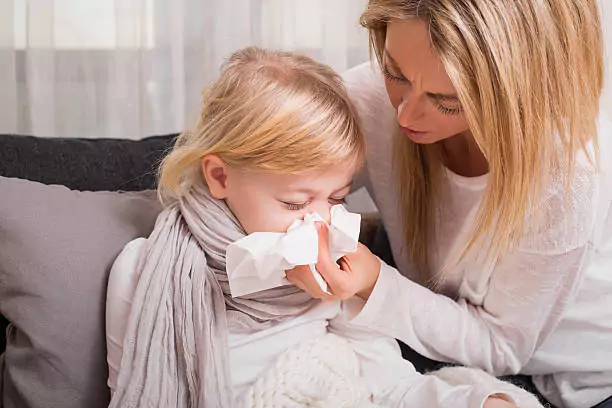Child With Cold and Flu
Introduction:
A child with cold and flu refers to a young individual who is currently experiencing symptoms of a respiratory infection caused by viruses. Colds and flu are common illnesses, especially among children, and they are characterized by symptoms such as congestion, coughing, sneezing, sore throat, fever, and fatigue. Caring for a child with a cold or flu involves providing comfort, ensuring proper hydration, managing symptoms, and taking precautions to prevent the spread of the illness to others. While these illnesses are generally mild, it’s important to monitor the child’s health and seek medical advice if needed.
Causes of Child With Cold and Flu:
A child with a cold or flu is typically infected by viruses, and several different types of viruses can cause these respiratory infections. The most common culprits include.
1. Rhinoviruses:
These viruses are the primary cause of the common cold and are highly contagious.
2. Influenza viruses:
Influenza, or the flu, is caused by influenza viruses (types A and B) and can lead to more severe respiratory symptoms.
3. Respiratory Syncytial Virus (RSV):
RSV is a common cause of respiratory infections, especially in infants and young children.
4. Adenoviruses:
Adenoviruses can cause a range of illnesses, including respiratory infections, and may affect the respiratory, gastrointestinal, and ocular systems.
5. Coronaviruses:
Some coronaviruses can cause mild respiratory infections, although certain strains, such as SARS-CoV-2 (responsible for COVID-19), can lead to more severe respiratory illnesses.
These viruses are typically transmitted through respiratory droplets when an infected person coughs or sneezes. Practicing good hygiene, such as regular handwashing, and avoiding close contact with sick individuals can help reduce the risk of infection.Top of Form
Symptoms Of Child With Cold and Flu:
- Fever
- Sneezing
- Cough
- Nasal Discharge
- Watery eyes
Treatment Of Child With Cold and Flu:
Rx (Prescription)
- Syp. Loratidine 5mg/5ml (Softin, Lorin-NSA) Or Syp. Cetirizine 5mg/5ml (Rigix, Zyretic) 0+0+1,1+0+1 (2-5 years = 5mg x OD/> 5years 5mg x BD)
- Syp. Cough suppressants (Babynol, Combinol Junior) 1-2-teaspoon BD/TDS
- Syp. Paracetamol (Calpol = 120mg/5ml, Panadol = 160mg/5 ml) TDS/QID (1 Teaspoonful = 5ml)
Dosage:
10-15mg/kg/Dose Or Syp. Ibuprofen (Brufen = 100mg/5ml, Brufen DS = 200mg/5ml)
Dosage 2:
10mg/kg/dose x 6-8 hourly (max daily dose:40mg/kg/day) TDS/QID (1 Teaspoonful = 5ml)
Note:
If sore throat or any sign of secondary infection than add 156.25mg/5ml (Augmentin, Calamox)
- Syp. Co-Amoxiclave 312.50mg/5ml (Augmentin DS, Calamox DS)
Dosage:
25-40mg/kg/day x divided every 8-12 hourly. TDS/BD (1 Teaspoonful = 5ml)
Child with Cold/Flu FAQs
- What is a child with a cold or flu?
A child with a cold or flu is a young individual experiencing symptoms of a respiratory infection caused by viruses. These symptoms typically include congestion, coughing, sneezing, sore throat, fever, and fatigue.
- What are the common causes of colds and flu in children?
Common causes of colds and flu in children include rhinoviruses, influenza viruses (types A and B), respiratory syncytial virus (RSV), adenoviruses, and certain strains of coronaviruses. These viruses are highly contagious and spread through respiratory droplets.
- What are the symptoms of a child with a cold or flu?
Symptoms of a child with a cold or flu may include fever, sneezing, cough, nasal discharge, and watery eyes.
- How can a child with a cold or flu be treated?
Treatment for a child with a cold or flu may include:
- Over-the-counter medications such as loratadine or cetirizine for allergies and cough suppressants for cough relief.
- Antibiotics such as co-amoxiclav may be prescribed if there are signs of secondary infection, such as a sore throat.
- What is the recommended dosage for over-the-counter medications for children with cold or flu?
The recommended dosage for over-the-counter medications varies based on the child’s age and weight. For example, loratadine or cetirizine may be given once daily for children aged 2-5 years and twice daily for children over 5 years. Cough suppressants and pain relievers should be administered according to the child’s weight, typically 10-15mg/kg/dose.
- What precautions should be taken when treating a child with a cold or flu?
It’s important to ensure proper hydration, monitor the child’s temperature, and seek medical advice if symptoms worsen or persist. Additionally, practicing good hygiene, such as frequent handwashing and avoiding close contact with sick individuals, can help prevent the spread of the illness.
- Are antibiotics necessary for treating a child with a cold or flu?
Antibiotics are not usually necessary for treating colds or flu caused by viruses. However, if there are signs of a secondary bacterial infection, such as a sore throat, antibiotics may be prescribed by a healthcare professional.
- How should medications for a child with a cold or flu be stored?
Medications should be stored in a safe place, out of reach of children, and according to their specific storage instructions, typically at room temperature away from moisture and sunlight.

